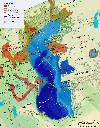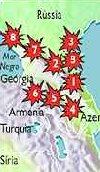| The Nagorno Karabach conflict |
 Azerbaijan
continues to live under the shadow of an unresolved 12-year-old conflict
with Armenian separatists over its Nagorno-Karabakh region. This
region was incorporated into Azerbaijan in 1921, under the orders of Stalin.
Encouraged by the mood of Perestroika and Glasnost, in February 1988 the
Nagorno-Karabagh Regional Assembly formally requested that the region be
transferred to neighbouring Armenia. Moscow rejected this request.
Azerbaijan
continues to live under the shadow of an unresolved 12-year-old conflict
with Armenian separatists over its Nagorno-Karabakh region. This
region was incorporated into Azerbaijan in 1921, under the orders of Stalin.
Encouraged by the mood of Perestroika and Glasnost, in February 1988 the
Nagorno-Karabagh Regional Assembly formally requested that the region be
transferred to neighbouring Armenia. Moscow rejected this request.
 By
the end of February 1988, the situation became worse with incidents between
Armenians and Azeris in Sumgait. Soviet troops were called in to restore
order. In November 1988 violence once again broke out in several cities.
Tens of thousands of Azeris and Armenians
were expelled from both republics, massacres occured, and with the breakup
of the Soviet Union in 1991, the situation had escalated into full-scale
war. By the time of the ceasefire was signed in May 1994 there were
over 20,000 dead, and over a million refugees. The Karabakh Armenians have
declared independence (Artsakh) and
seized almost 20% of the country's territory,
creating almost 1 million Azeri refugees in the process.
By
the end of February 1988, the situation became worse with incidents between
Armenians and Azeris in Sumgait. Soviet troops were called in to restore
order. In November 1988 violence once again broke out in several cities.
Tens of thousands of Azeris and Armenians
were expelled from both republics, massacres occured, and with the breakup
of the Soviet Union in 1991, the situation had escalated into full-scale
war. By the time of the ceasefire was signed in May 1994 there were
over 20,000 dead, and over a million refugees. The Karabakh Armenians have
declared independence (Artsakh) and
seized almost 20% of the country's territory,
creating almost 1 million Azeri refugees in the process.
 Both
sides have generally observed the Russian-mediated cease-fire. Armenia
supports ethnic Armenians in the Nagorno-Karabakh region of Azerbaijan
in the long-standing, separatist conflict against the Azerbaijani Government.
Negotiations have been long but inconclusive.
Both
sides have generally observed the Russian-mediated cease-fire. Armenia
supports ethnic Armenians in the Nagorno-Karabakh region of Azerbaijan
in the long-standing, separatist conflict against the Azerbaijani Government.
Negotiations have been long but inconclusive.
 The
Armenians seem to be willing to return to Azerbaijan most territories they
currently occupy around, south and east of Nagorno-Karabakh, including
the towns of Fizuli, Agdam and Jebrail, but they insist in keeping a corridor
around Lechin connecting the province to mainland Armenia. The Armenians
also want to keep Kelbajar, which has gold mines nearby. It has been speculated
that in compensation the Armenians may offer Azerbaijan a narrow corridor
connecting Azerbaijan to Nakichevan, along the Iranian border.
The
Armenians seem to be willing to return to Azerbaijan most territories they
currently occupy around, south and east of Nagorno-Karabakh, including
the towns of Fizuli, Agdam and Jebrail, but they insist in keeping a corridor
around Lechin connecting the province to mainland Armenia. The Armenians
also want to keep Kelbajar, which has gold mines nearby. It has been speculated
that in compensation the Armenians may offer Azerbaijan a narrow corridor
connecting Azerbaijan to Nakichevan, along the Iranian border.
| Border with Georgia |
 Large
stretches of the border between Azerbaijan and Georgia were never marked
in Soviet times, leaving a number of ambiguos situations to be solved.
In a very un-Caucasian way so far this has been an issue tackled mostly
at the negotiation table, although without great progress, maybe because
the stakes are low.
Large
stretches of the border between Azerbaijan and Georgia were never marked
in Soviet times, leaving a number of ambiguos situations to be solved.
In a very un-Caucasian way so far this has been an issue tackled mostly
at the negotiation table, although without great progress, maybe because
the stakes are low.
Most areas in dispute are very low profile,
except a stretch of border in Agstafa rayon.
The David Gareja monastery complex is located on the half-desert
slopes of Mount Gareja. Part of the border passes through the top of the
813-meter-high Udabno / Keshishdag ridge, which harbors cave monasteries
on its top and also on the northern (Georgian-controlled) and southern
(Azerbaijani-controlled) slopes. Part of the complex is also located
on the Azeri side of the border, in Agstafa rayon. The complex, which contains
a rich collection of cave frescoes, has been a site for conflict as well
as for contemplation, ever since construction began in the 6th century.
Azerbaijan claims th monastery of Bertubani, which features frescoes of
the legendary 12th-13th century Georgian Queen Tamara and her son, Giorgi
IV is on its territory. To hold on to the churches on Georgian territory,
Tbilisi has proposed giving Azerbaijan an as yet publicly unspecified section
of Georgian land near the Azerbaijani border. Azerbaijani officials, however,
say that they are unwilling to consider the exchange. The monastery
complex, which has withstood attacks by Tamerlane and Shah Abbas alike,
holds strategic significance for both Azerbaijan and Georgia. From the
Udabno ridge, both Azerbaijani and Georgian territory can be easily monitored.
| Sharing the Caspian Sea |
 The
way of sharing the Caspian Sea is not yet clearly determined among
Azerbaijan, Iran, Kazakhstan, Russia, and Turkmenistan, with conflicting
criteria being suggested for the division. In fact two totally different
international law perspectives on the Caspian existed until recently. Russia
and Iran viewed the Caspian as a lake with common resources. Azerbaijan,
Kazakhstan and Turkmenistan considered the Caspian as a sea with national
sectors (click map on the right).
The
way of sharing the Caspian Sea is not yet clearly determined among
Azerbaijan, Iran, Kazakhstan, Russia, and Turkmenistan, with conflicting
criteria being suggested for the division. In fact two totally different
international law perspectives on the Caspian existed until recently. Russia
and Iran viewed the Caspian as a lake with common resources. Azerbaijan,
Kazakhstan and Turkmenistan considered the Caspian as a sea with national
sectors (click map on the right).
Since December 1998 Russia and Iran are no longer insisting on the inviolability of the sea’s former status based on the 1921 and 1940 Soviet-Iranian agreements (meaning indivisibility of the sea, including its seabed, and the impossibility of foreign firms acting without the consent of all the countries of the region).
The question now is what should be divided and how. Kazakstan and Russia are in favour of dividing the Caspian seabed alone, while the sea’s waters remain in common use. On the contrary, Azerbaijan and Turkmenistan are in favour of dividing both the sea’s bed and its waters. Iran takes a special position: while advocating joint use of the seabed and the water, Tehran supports full division of the Caspian if the other littoral states agree to take this step.
 Azerbaijan
remains locked in disputes with Turkmenistan and Iran over competing claims
to overlapping fields. Turkmenistan and Azerbaijan have traded harsh words
over the Kyapaz-Serdar, Khazar, and Osman fields, while Azerbaijan has
objected to Iran's decision to award Royal Dutch/Shell and Lasmo a license
to conduct seismic surveys in a region that Azerbaijan considers to fall
in its territory. In July 2001, tensions flared in the South Caspian when
a British Petroleum (BP) ship, licensed to explore Azerbaijan's Araz, Alov,
and Sharg concession, was ordered to leave the area by an Iranian gunboat,
since Iran considers the area, which it calls Alborz, to be a part of the
Iranian sector of the sea.
Azerbaijan
remains locked in disputes with Turkmenistan and Iran over competing claims
to overlapping fields. Turkmenistan and Azerbaijan have traded harsh words
over the Kyapaz-Serdar, Khazar, and Osman fields, while Azerbaijan has
objected to Iran's decision to award Royal Dutch/Shell and Lasmo a license
to conduct seismic surveys in a region that Azerbaijan considers to fall
in its territory. In July 2001, tensions flared in the South Caspian when
a British Petroleum (BP) ship, licensed to explore Azerbaijan's Araz, Alov,
and Sharg concession, was ordered to leave the area by an Iranian gunboat,
since Iran considers the area, which it calls Alborz, to be a part of the
Iranian sector of the sea.
On the terrain the Caspian problem has already caused several incidents, mostly involving on one side Iranian Navy and Air Force and on the other ships carrying out marine survey or other vessels linked to oil and gas exploitation. The main point of attrition has been Azerbaijan's Araz, Alov, and Sharg concession, which Iran calls Alborz and considers to be a part of the Iranian sector of the sea. The stakes are high in this 'great game' for power and influence, oil and gas, and above all money, billions of dollars of it, beneath the Caspian, this is why Russia is building up a naval force for the inland sea.
See also: Environment,
Ports
| Summary of disputes in the Caucasus |
 1
- Chechnya / Russia conflict, also affecting Ingushetia and Dagestan
1
- Chechnya / Russia conflict, also affecting Ingushetia and Dagestan
2 - Ingushetia / North Ossetia border
dispute
3 - Strong separatist trend in Kalmukia
4 - Azerbaijan / Armenian dispute over
Nagorno-Karabach
5 - Georgia / Ossetia dispute
6 - Georgia / Abkhazia dispute
7 - Balkar independence movement in Kabardino-Balkaria
8 - Karachay-Cherkessia tension between
Karachays and Cherkesses
9 - Dagestan: ethnic tension between Avars
and Laks